Eye Evaluation
An Eye Evaluation is a series of tests performed by an Ophthalmologist, Optometrist, Orthoptist or Optician, to assess a Patients vision and ability to focus and distinguish between different objects, as well as other eye-related tests and examinations.
The Eye Evaluation Form is used to document the findings of a series of eye tests that the Practitioner has performed on the Patient. Practitioners are able to make visual indications by drawing on the provided images and upload images from an external source. The form allows the Practitioner to bill the Patient whilst completing the form as billing codes are automatically added when the test results are completed.
- The contents of this user manual will consist of the following information:
- Patient Examination Information
- General Examination
- External View
- Anterior View
- Fundoscopy
- Posterior View
- Macular
- Vessels
- Investigations
- Add Images
- Notes, Management, Discussion and Diagnosis
- Notes
- Management
- Discussion
- Diagnosis
- Billing Codes
- Complete and Finalise All Stages
- Complete
- Finalise All Stages
- Print and Download
- Download
- Save and Close
- This user manual will start on the Clinical screen.
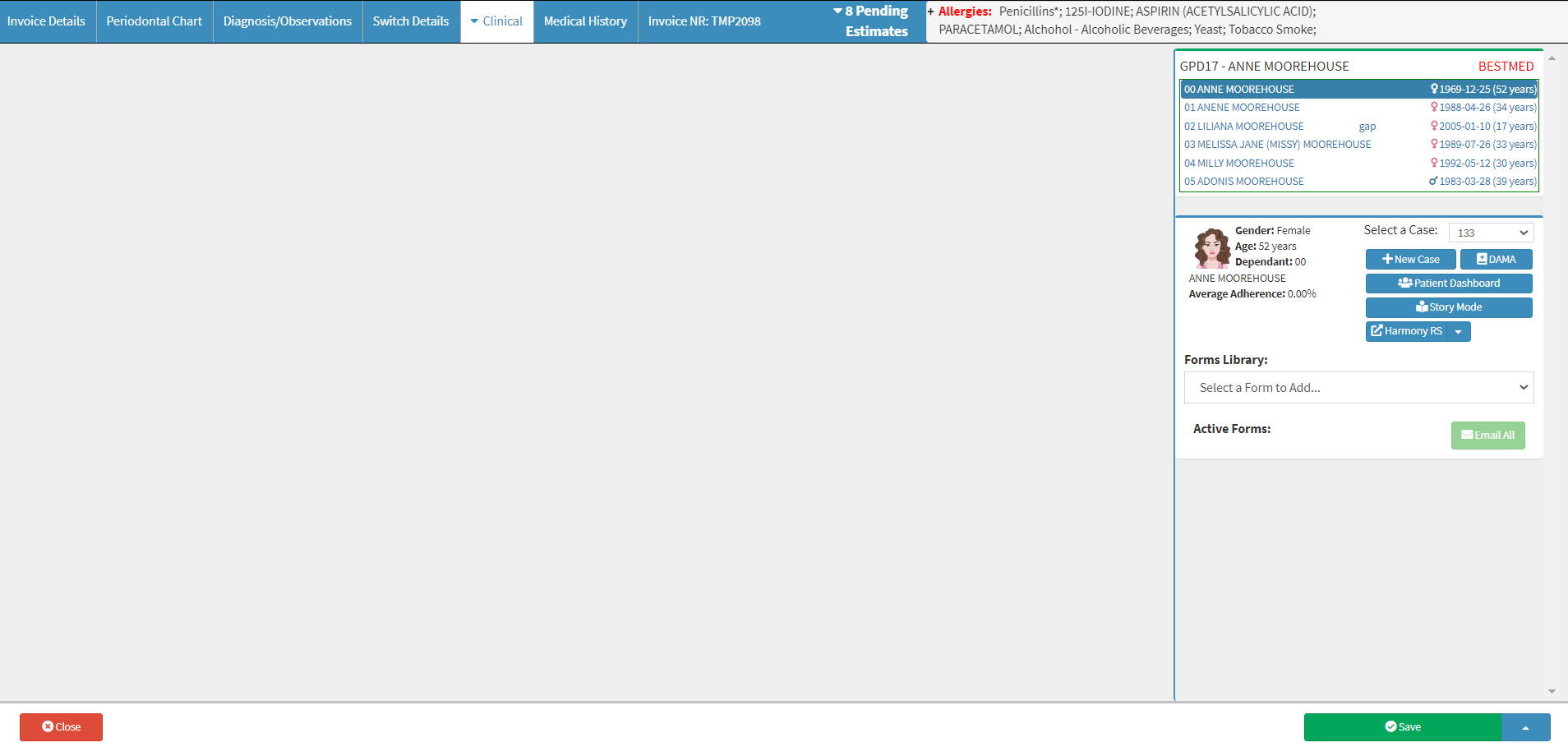
- For more information regarding how to navigate to the Clinical screen, please refer to the user manual: Clinical Screen Overview.
- Click on the Forms Library drop-down menu on the Clinical Sidebar.

- Select the Eye Eval form.
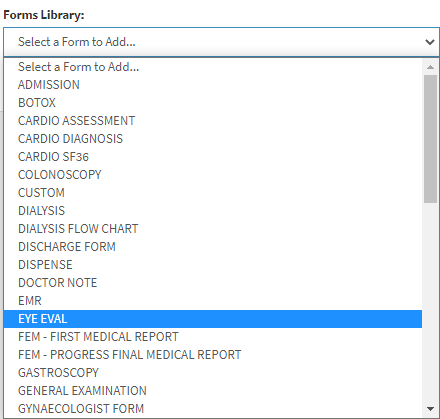
- The form will be added to the Clinical Sidebar under the Active Forms section.

- The Eye Eval form, Eye Examination panel will open.
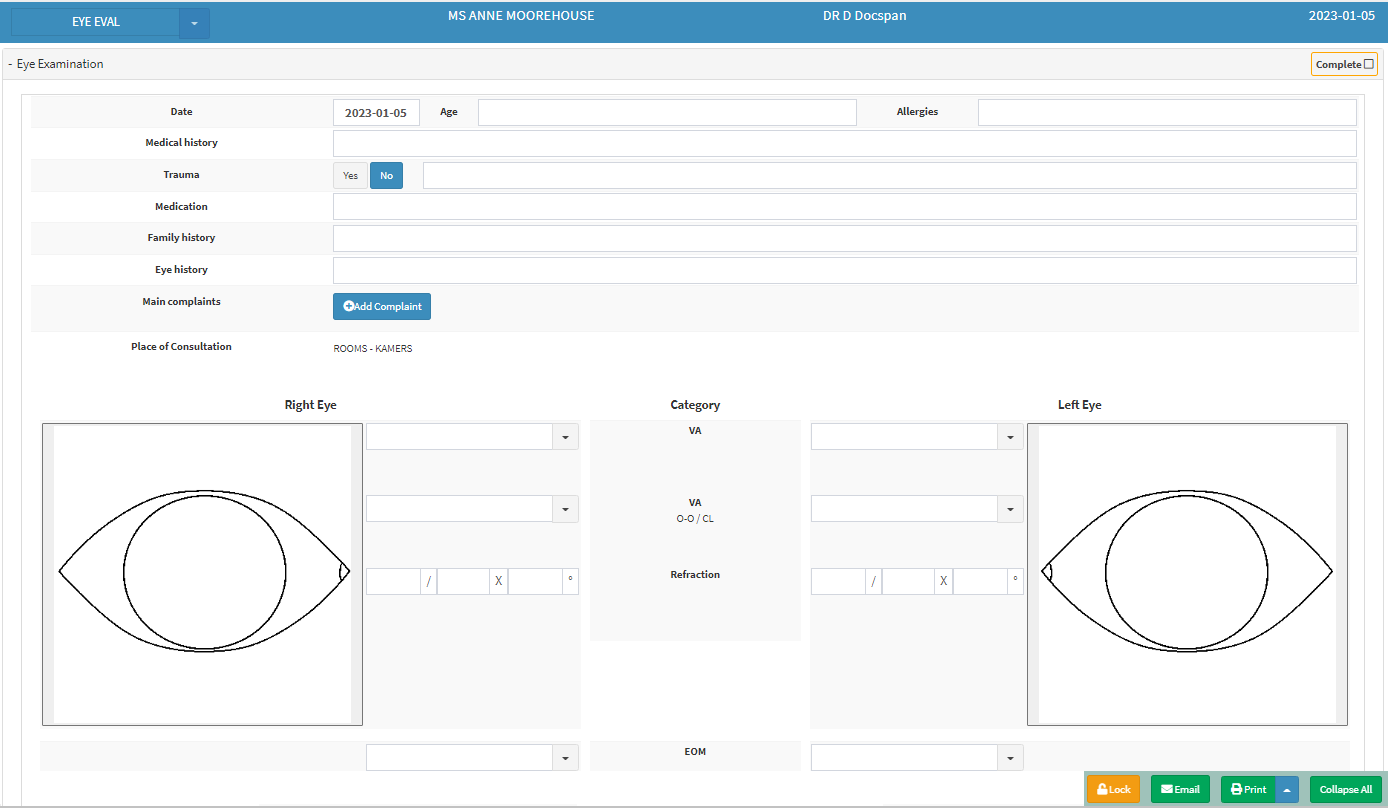
- An explanation will be given for each field and option available on the Eye Eval form:
Patient Examination Information
Details regarding the Patients history and current symptoms, as well as when and where the exam took place.

- An explanation will be given for each field and option in the Patient Examination Information section:
![]()
- Date: The date that the examination took place.
- Click on the Date field to open the date picker if the user would like to change the date on which the examination was done. The date that is displayed will by default be today's date.
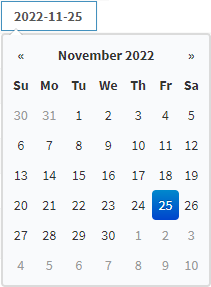
- Click on the desired date to make a selection.
![]()
- Age: How old the Patient is in years.
- Click on the Age field to enter the current age of the Patient who is being examined. The Patients' age is displayed in the Clinical Sidebar.
![]()
- Allergies: Any medication or natural substance that the Patient is allergic to. For example, Penicillin or grass.
- Click on the Allergies field to enter any allergies of the Patient who is being examined.
- For more information regarding how to view and set up a Patient's allergies, please refer to the user manual: Allergies.
![]()
- Medical History: A record of health information about the Patient that relates to any chronic/hereditary illnesses, or previous procedures/operations which are relevant to the treatment of the Patient.
- For more information regarding how to access and set up a Patient's Medical History, please refer to the user manual: Medical History.
![]()
- Trauma: Has the Patient suffered any serious injuries, due to an accident or physical abuse.
- Click on the No button to indicate that no trauma was experienced. The No button will be selected by default when the form is opened.
![]()
- Click on the Yes button to indicate that the Patient has suffered from Trauma.
![]()
- Click on the Trauma field to enter any information regarding the trauma, if Yes was selected.
![]()
- Medication: Any medicine that the Patient is currently taking, both chronic and acute.
- Click on the Medication field to enter the names of the medicines that the Patient is currently taking.
![]()
- Family History: A record of hereditary illnesses and conditions that run in the Patients' family, such as Heart Disease, Retinitis Pigmentosa etc. For more information regarding a Patient's Family History, please refer to the user manual: General History.
![]()
- Eye History: Previous problems/medical conditions relating to the eyes.
- Click on the Eye History field to enter any information regarding the history of the Patients' eyes.
![]()
- Main Complaints: Why the Patient is consulting the Practitioner as well as any symptoms that are being experienced.
- Click on the + Add Complaint button.
- A self-learning field will open. Once a user enters information into a self-learning field, the information that has been entered will become an option available on the drop-down menu, for easy access, which saves time.
![]()
- Click on the Main Complaint field to enter the complaint and symptoms.
![]()
- Click on the Select... drop-down menu to indicate where the Patient's symptoms are being experienced.
![]()
- Select an option from the list that has become available:
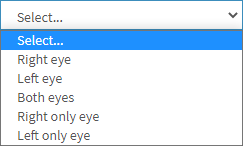
- Right Eye: The eye on the right side of the face.
- Left Eye: The eye on the left side of the face.
- Both Eyes: The eye on the left and right side of the face.
- Right Eye only: The problem only affects the eye on the right side of the face.
- Left Eye only: The problem only affects the eye on the left side of the face.
- Click on the Delete button to remove a complaint from the list.
![]()
Please Note: More than one symptom/complaint can be added, by Clicking on the + Add Complaint as many times as needed.
![]()
- Place of Consultation: Where the consultation took place. The information displayed in the Place of Consultation field is automatically populated depending on which Service Centre was selected when the booking was made.
General Examination
An evaluation of the Patients eyes. Allows the Practitioner to document all the findings as observed during the evaluation
- An explanation will be given for each field and option in the General Examination section:
Please Note: The same options are available for both eyes. Only one explanation will be given that is relevant to both eyes.
External View

- External View: A line drawing of the front view of the eye.
- Click on the Basic Eye Drawing.
- The Video Capture screen will open where the user is able to make visual indications of the Patient's eye.
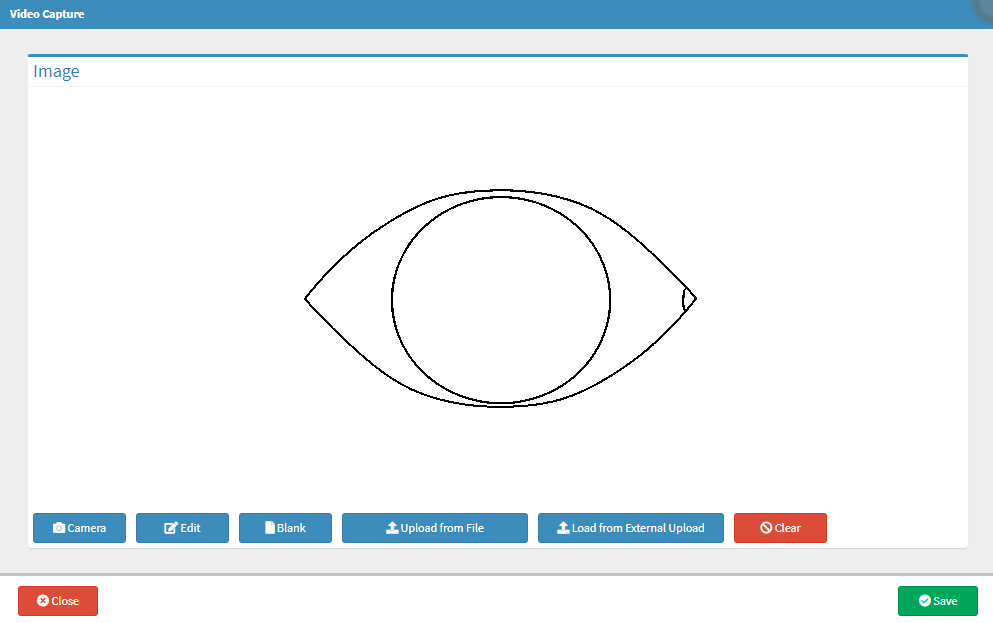
- For more information regarding how the Video Capture screen works, please refer to the user manual: How to Upload an Image/Photo.
![]()
- VA: Visual Acuity - The distance (denominator) at which an optimally seeing eye can identify forms observed by an eye test at a standard distance (numerator).
- Click on the VA field to enter the findings. The VA field is a self-learning field that will remember the information that has been entered into the field, which will then become available on the drop-down menu, for easy access, which saves time.
![]()
- VA (O-O/CL): Visual Acuity with glasses or contact lenses. The distance (denominator) at which the Patient can identify forms observed by an eye test at a standard distance (numerator), which is typically 6 meters with glasses or contact lenses.
- Click on the VA (O-O/CL) field to enter the findings when the Patient is wearing contact lenses or glasses. The VA (O-O/CL) field is a self-learning field that will remember the information that has been entered into the field, which will then become available on the drop-down menu, for easy access, which saves time.
![]()
- Refraction: How light that enters the eyes bends in relation to the retina. The test is conducted by shining a light into the eyes or using a refractor/phoropter.
- Click on the Refraction field to enter the relevant findings. The Refraction field is a self-learning field that will remember the information that has been entered into the field, which will then become available on the drop-down menu, for easy access, which saves time.
![]()
- EOM: Extra-ocular muscles are six muscles that control the movement of the eye and the eyelid elevation.
- Click on the EOM field to enter the findings. The EOM field is a self-learning field that will remember the information that has been entered into the field, which will then become available on the drop-down menu, for easy access, which saves time.
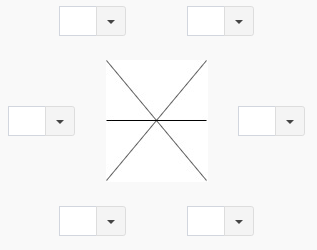
- EOM Diagram: There are 6 extra-ocular muscles in the eye:
- An explanation will be given for each eye muscle (clockwise starting in the left top corner of the image):
- Superior Rectus: Elevates the eye allowing upper movement of the cornea.
- Superior Oblique: Controls the downward and outward movement of the eye.
- Medial Rectus: Works in conjunction with the Lateral Rectus, controlling the eye to move from side to side.
- Inferior Rectus: Controls the downward gaze movement of the eye.
- Inferior Oblique: Controls the ability to elevate and flex the eyes as well as to control how the eye rotates away from the nose.
- Lateral Rectus: Moves the eye laterally and side to side in conjunction with the Medial Rectus.
- Click on the desired field in the EOM Diagram to enter the findings.
Please Note: Each field in the EOM Diagram is a self-learning field that will remember the information that has been entered into the field, which will then become available on the drop-down menu, for easy access, which saves time.
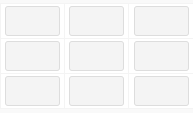
- Click on the desired EOM button to add a single indication to that specific block.
![]()
- Click on the same EOM button for a second time to add a second indication to the block.
![]()
- Click on the same EOM button for a third time to clear the contents of the button.

- Hertels: A Hertel exophthalmometer is used to measure the distance between the lateral orbital rim and the most anterior position of the cornea. In general, measurements between the two eyes should be equal.
- Click on the Hertels field to enter the results of the test that has been performed.
Please Note: Each field in the Hertels section is a self-learning field that will remember the information that has been entered into the field, which will then become available on the drop-down menu, for easy access, which saves time.
Anterior View
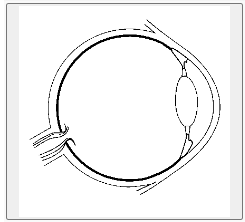
- Anterior Image: A basic line drawing of all the components of the eyes' anatomy.
- Click on the Anterior Image.
- The Video Capture screen will open where the user is able to make visual indications of the Patient's eye.

- For more information regarding how the Video Capture screen works, please refer to the user manual: How to Upload an Image/Photo.
- Eyelids: An eyelid is a flap of skin above the eye, which shields and protects the eyeball from injury. The eyelids provide moisture in order for the conjunctiva and cornea to function normally.
- Click on the Eyelids field to enter the findings. The Eyelids field is a self-learning field that will remember the information that has been entered into the field, which will then become available on the drop-down menu, for easy access, which saves time.
![]()
- Conjunctiva: A mucous membrane that covers the front of the eye and lines the inside of the eyelids to lubricate the eyes by producing mucus and tears. The Conjunctiva prevents microbes from entering the eye and covers the sclera.
- Click on the Conjunctiva field to enter the findings. The Conjunctiva field is a self-learning field that will remember the information that has been entered into the field, which will then become available on the drop-down menu, for easy access, which saves time.
![]()
- Cornea: A transparent layer that covers the pupil and iris which allows light to enter through the eyes.
- Click on the Cornea field to enter the findings. The Cornea field is a self-learning field that will remember the information that has been entered into the field, which will then become available on the drop-down menu, for easy access, which saves time.
![]()
- AC: The Anterior Chamber is a plasma-filled space between the innermost surface of the cornea and the iris.
- Click on the AC field to enter the findings. The AC field is a self-learning field that will remember the information that has been entered into the field, which will then become available on the drop-down menu, for easy access, which saves time.
![]()
- Iris/Pupil: Iris - A thin, circular structure in the eye, responsible for controlling the diameter and size of the pupil and thus the amount of light reaching the retina. Eye colour is defined by that of the iris. A Pupil is a black hole in the centre of the iris of the eye that allows light to strike the retina. The size of the pupil changes according to the amount of light that enters the eye. The pupil will decrease in size the brighter the light is and increases in size when the amount of light decreases.
- Click on the Iris/Pupil field to enter the findings. The Iris/Pupil field is a self-learning field that will remember the information that has been entered into the field, which will then become available on the drop-down menu, for easy access, which saves time.
![]()
- RRR: Round Regular Reacting - indicates whether the eyes are circular, normal and responsive.
- Click on the No button to indicate that the eye is not reactive.
![]()
- Click on the Yes button to indicate that the Patient's eyes are responsive.
![]()
![]()
- RAPD: Relative Afferent Pupillary Defect - A condition of the eyes where the Patient's pupils respond differently when a light is shined in one eye at a time due to an asymmetrical disease of the retina or optic nerve.
- Click on the No button to indicate that there is no Relative Afferent Pupillary Defect present.
![]()
- Click on the Yes button to indicate that the Patient has a Relative Afferent Pupillary Defect.
![]()
![]()
- Colour Vision: The capacity to distinguish between different wavelengths of light and to sense changes in colour. The normal human eye can differentiate between hundreds of wavelength bands when received by the retina colour-sensing cells (cones). Cones are sensitive to either red, green or blue light which represents long, medium and short wavelengths.
- Click on the Colour Vision field to enter the findings. The Colour Vision field is a self-learning field that will remember the information that has been entered into the field, which will then become available on the drop-down menu, for easy access, which saves time.
![]()
- Brightness: A Brightness Acuity Test (BAT) is used to determine whether a Patient has a glare disability, using different bright light conditions such as direct overhead sunlight, a partly cloudy day, and bright overhead commercial lighting.
- Click on the Brightness field to enter the results out of 10, of the test that has been performed.
![]()
- IOP: Intraocular Pressure - The pressure of the fluid inside the eye. The method used to determine intraocular pressure is Tonometry. IOP is an essential aspect in the evaluation of Patients at risk of Glaucoma.
- Click on the IOP field to enter the findings. The IOP field is a self-learning field that will remember the information that has been entered into the field, which will then become available on the drop-down menu, for easy access, which saves time.
![]()
- Lens: Located in the eyeball there is an ellipsoid structure, known as the Lens, which is located behind the iris and in front of the ciliary muscle. The Lens is surrounded by ciliary processes and is connected by zonular fibres. The Lens is made up of three major components: the capsule, the epithelium, and the fibres.
- Click on the Lens field to enter the findings. The Lens field is a self-learning field that will remember the information that has been entered into the field, which will then become available on the drop-down menu, for easy access, which saves time.
![]()
- Vitreous: Fluid with a gel-like consistency that fills the space between the lens and the retina of the eyes which assists the eyes to maintain a round shape.
- Click on the Vitreous field to enter the findings. The Vitreous field is a self-learning field that will remember the information that has been entered into the field, which will then become available on the drop-down menu, for easy access, which saves time.
Fundoscopy
An examination where the Practitioner uses an Ophthalmoscope. There are three main aspects to a Fundoscopy: Brightness, Focus and Light which allows the Practitioner to examine the retina. Fundoscopies are generally used to check for eye issues, such as Glaucoma, Macular degeneration, eye cancer, optic nerve problems or eye injuries.

- An explanation will be given for each field and option in the Fundoscopy section:
Posterior View

- Posterior Image: A basic line drawing of all components of the retina.
- Click on the Posterior Image.
- The Video Capture screen will open where the user is able to make visual indications of the Patient's eye.

- For more information regarding how the Video Capture screen works, please refer to the user manual: How to Upload an Image/Photo.
![]()
- Disc: Also known as the Optic Disk/Optic Nerve Head, is the entry point for the main blood vessels that supply the retina. Nerve fibres are carried from the eyes toward the brain through the Optic Disk.
- Click on the Disc field to enter the results out of 10, of the test that has been performed.
![]()
- NRR Colour: Neuro-retinal rim - A network of small blood vessels that are orange and/or pink in colour. The Neuro-retinal Rim is an intrapapillary equivalent of the optic nerve fibres and one of the most critical morphologic markers for detecting glaucomatous optic neuropathy and grading the extent of glaucomatous optic nerve damage.
- Click on the NRR Colour field to enter the findings. The NRR Colour field is a self-learning field that will remember the information that has been entered into the field, which will then become available on the drop-down menu, for easy access, which saves time.
![]()
- ISNT: Inferior, Superior, Nasal, Temporal - The ISNT rule is an easy way to remember how the optic nerve should look like in a normal eye. The Neuro-retinal rim is normally thickest inferiorly and weakest temporally. However, with glaucoma, you may notice vertical thinning and atrophy along the inferior and superior rims.
- Click on the ISNT field to enter the findings. The ISNT field is a self-learning field that will remember the information that has been entered into the field, which will then become available on the drop-down menu, for easy access, which saves time.
![]()
- SVP: Spontaneous Venous Pulsation - The result of pressure fluctuation along the retinal vein when crossing the lamina cribrosa. When intracranial pressure (ICP) rises, intracranial pulse pressure rises to meet intraocular pulse pressure, and SVP ends.
- Click on the SVP field to enter the findings. The SVP field is a self-learning field that will remember the information that has been entered into the field, which will then become available on the drop-down menu, for easy access, which saves time.
![]()
- Other: Any additional findings that are observed.
- Click on the Other field to enter the findings. The Other field is a self-learning field that will remember the information that has been entered into the field, which will then become available on the drop-down menu, for easy access, which saves time.
Macular
The eye's macula is located near the centre of the retina and is responsible for sharp, clear, straight-ahead vision. The retina is the paper-thin tissue that lines the back of the eye and contains the photoreceptor (light-sensing) cells (rods and cones) that send visual signals to the brain. Macular Degeneration is common in older Patients which causes reading and recognising faces to become difficult.
- An explanation will be given for each field and option in the Macular section:
- FR: Foveal Reflex - A reflection of bright light to look for the presence of haemorrhage.
- Click on the FR field to enter the findings. The FR field is a self-learning field that will remember the information that has been entered into the field, which will then become available on the drop-down menu, for easy access, which saves time.
![]()
- Other: Any additional findings that are observed in the Macular.
- Click on the Other field to enter the findings. The Other field is a self-learning field that will remember the information that has been entered into the field, which will then become available on the drop-down menu, for easy access, which saves time.
Vessels
Each eye is supplied with blood via an ophthalmic artery and a central retinal artery (an artery that branches from the ophthalmic artery). Ophthalmic veins (vortex veins) and a central retinal vein drain blood from the eye in the same way. These blood veins enter and exit the eye from the rear.
- An explanation will be given for each field and option in the Vessels section:
![]()
- A:V: Artery-to-vein - The ratio of the number of arteries to the number of veins in the eyes. Also referred to as the ratio of retinal arteriolar to venular diameters, which is usually two-thirds.
- Click on the A:V field to enter the findings. The A:V field is a self-learning field that will remember the information that has been entered into the field, which will then become available on the drop-down menu, for easy access, which saves time.
![]()
- Other: Any additional observations made by the Practitioner regarding the vessels in the eye.
- Click on the Other field to enter the findings. The Other field is a self-learning field that will remember the information that has been entered into the field, which will then become available on the drop-down menu, for easy access, which saves time.
![]()
- Retina: The retina is the paper-thin tissue that lines the back of the eye and contains the photoreceptor (light-sensing) cells (rods and cones) that send visual signals to the brain.
Investigations
A series of tests and procedures that can be used to detect conditions, determine a diagnosis, assist in forming a treatment plan, and monitor the progress of the condition. Investigations may consist of scans, blood tests, physical examinations and investigative procedures etc.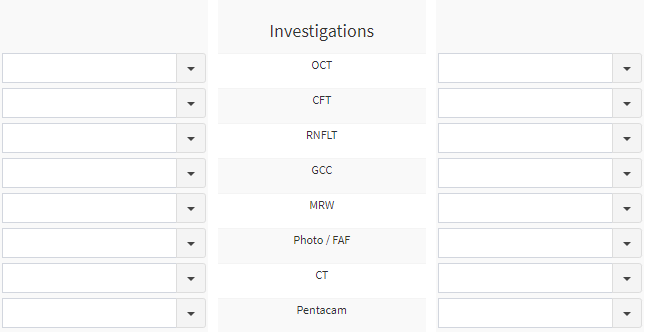
- An explanation will be given for each field and option in the Investigations section:
![]()
- OCT: Ocular Coherence Tomography - An imaging technique that uses low-coherence light to capture 2D, 3D and micrometre resolution images. The test is non-invasive that takes cross-section images of the retina. Goving the Patient colour-coded pictures of the back of the eye including individual layers of the retina. Therefore, if there is bleeding into the back of the eye or fluid collection in the retina, the OCT can inform the Practitioner in which layer of the retina the fluid or bleeding is.
- Click on the OCT field to enter the findings. The OCT field is a self-learning field that will remember the information that has been entered into the field, which will then become available on the drop-down menu, for easy access, which saves time.
![]()
- CFT: Central Foveal Thickness - The measurement used to determine the thickness of the fovea.
- Click on the CFT field to enter the findings. The CFT field is a self-learning field that will remember the information that has been entered into the field, which will then become available on the drop-down menu, for easy access, which saves time.
![]()
- RNFLT: Retinal Nerve Fiber Layer Thickness - Caused by axonal oedema that is present when a Patient has optic neuritis, acute ischemia and short-term intracranial hypertension. Enables early detection of glaucoma.
- Click on the RNFLT field to enter the findings. The RNFLT field is a self-learning field that will remember the information that has been entered into the field, which will then become available on the drop-down menu, for easy access, which saves time.
![]()
- GCC: Ganglion Cell Complex - The three deepest retinal layers, known as the nerve fibre layer, the ganglion cell layer, and the inner plexiform layer.
- Click on the GCC field to enter the findings. The GCC field is a self-learning field that will remember the information that has been entered into the field, which will then become available on the drop-down menu, for easy access, which saves time.
![]()
- MRW: Minimum Rim Width - A measurement of the thickness of the neuroretinal rim tissue that is contained within the optic disc using BMO (Bruch's membrane opening) as the anatomic reference point. MRW is defined as the smallest distance between BMO and the internal limiting membrane.
- Click on the MRW field to enter the findings. The MRW field is a self-learning field that will remember the information that has been entered into the field, which will then become available on the drop-down menu, for easy access, which saves time.
![]()
- Photo/FAF: Fundus Autofluorescence - A non-invasive retinal imaging method that provides a density map of lipofuscin, the primary ocular fluorophore, in the retinal pigment epithelium and that detects fluorophores, naturally occurring molecules that absorb and cast light off specified wavelengths.
- Click on the Photo/FAF field to enter the findings. The Photo/FAF field is a self-learning field that will remember the information that has been entered into the field, which will then become available on the drop-down menu, for easy access, which saves time.
![]()
- CT: Computed Tomography - A diagnostic tool used to create cross-section images of specific sections of the head to get a more detailed x-ray view of the bones, vessels and soft tissue to detect any issues that may be present relating to the eyes.
- Click on the CT field to enter the findings. The CT field is a self-learning field that will remember the information that has been entered into the field, which will then become available on the drop-down menu, for easy access, which saves time.
![]()
- Pentacam: The Pentacam is a complex diagnostic instrument that has significantly improved the accuracy of evaluating whether or not a Patient is a good candidate for LASIK. With the Pentacam, Practitioners can examine the anatomy of the cornea in great detail, providing 3D imaging of the cornea as well as precise thickness measurements.
- Click on the Pentacam field to enter the findings. The Pentacam field is a self-learning field that will remember the information that has been entered into the field, which will then become available on the drop-down menu, for easy access, which saves time.
Add Images
Allows the Practitioner to upload pictures, scans, x-rays, and draw images relating to the Patients' eyes.

- Click on the + Add Image button to upload images.
![]()
- The Video Capture screen will open where the Practitioner is able to take images, upload pictures from a device, draw free-hand images or upload images from an external source.
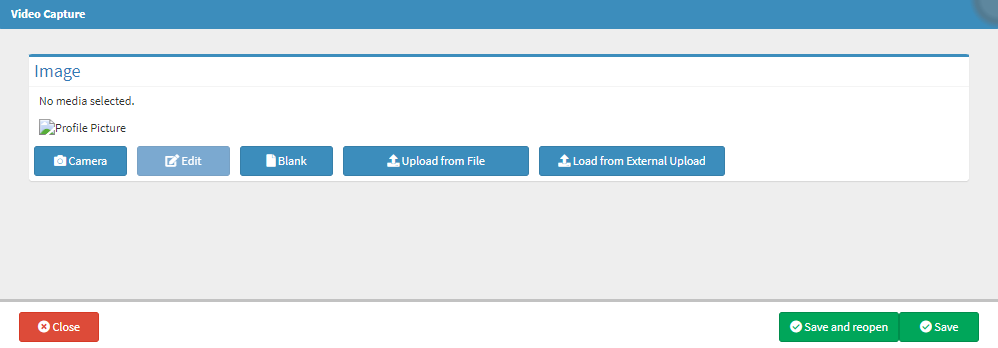
- For more information regarding how the Video Capture screen works, please refer to the user manual: How to Upload an Image/Photo.
Notes, Management, Discussion and Diagnosis
All the extra information that is relevant to the tests and scans that have been done. The Practitioner is able to add general notes regarding the evaluation, how the Patients' condition will be managed and what will happen next, if surgery is needed, if there are any alternative options that can be considered and what the complications are regarding all the Patients' options. The Practitioner is also able to assign a formal diagnosis with an ICD-10 code, to the Patient.

Notes

- Notes: Any additional information regarding the Eye Evaluation.
- Click on the Notes free text field to enter the relevant information. The Notes field has no character limit.
Management

- Management: How the Practitioner suggests that the Patient's conditions should be managed.
- Click on the Management free text field to enter the relevant information. The Management field has no character limit.
Discussion
![]()
- An explanation will be given for each option in the Discussion section.
- Tick the relevant checkbox to indicate that the option was discussed with the Patient:
- Surgery: The Patient will need need to undergo a procedure as treatment for the condition that has been diagnosed.
- Alternatives: Other treatments or procedures besides surgery that are available to the Patient.
- Risks & Complications: The Practitioner has advised the Patient what the dangers and possible complications are for the suggested treatments and procedures that the Patient may require to treat the diagnosed condition.
Diagnosis
![]()
- Diagnosis: A Diagnosis is the detection of a medical issue that has been identified by a Practitioner, through various tests and procedures. Once identification of the illness has been made, the Diagnosis is added to the form with an accompanying ICD-10 code. The ICD-10 code is linked to a diagnosis, which assists the Practitioner with identifying the Patient's illness. Knowing the code allows for the planning of any further Clinical Procedures necessary.
- Click on the Diagnosis field to enter a diagnosis for the Patient. The Practitioner is able to use the name or ICD-10 code of the diagnosis.
![]()
- A list will appear as the user types, from which the Practitioner is able to choose the condition that is relevant to the Patient. Only one character is needed to make the list appear.

Please Note: The list of results will disappear if the user takes too long to make a selection.
- Click on the relevant diagnosis to make a selection.
- The selected diagnosis will be added to the Diagnosis section.

Please Note: More than one diagnosis can be added.

- Alternatively, Click on the ... (ellipse) button next to the Diagnosis field to add a Diagnosis from the ICD-10 code list.
- The ICD10 Builder screen will open.
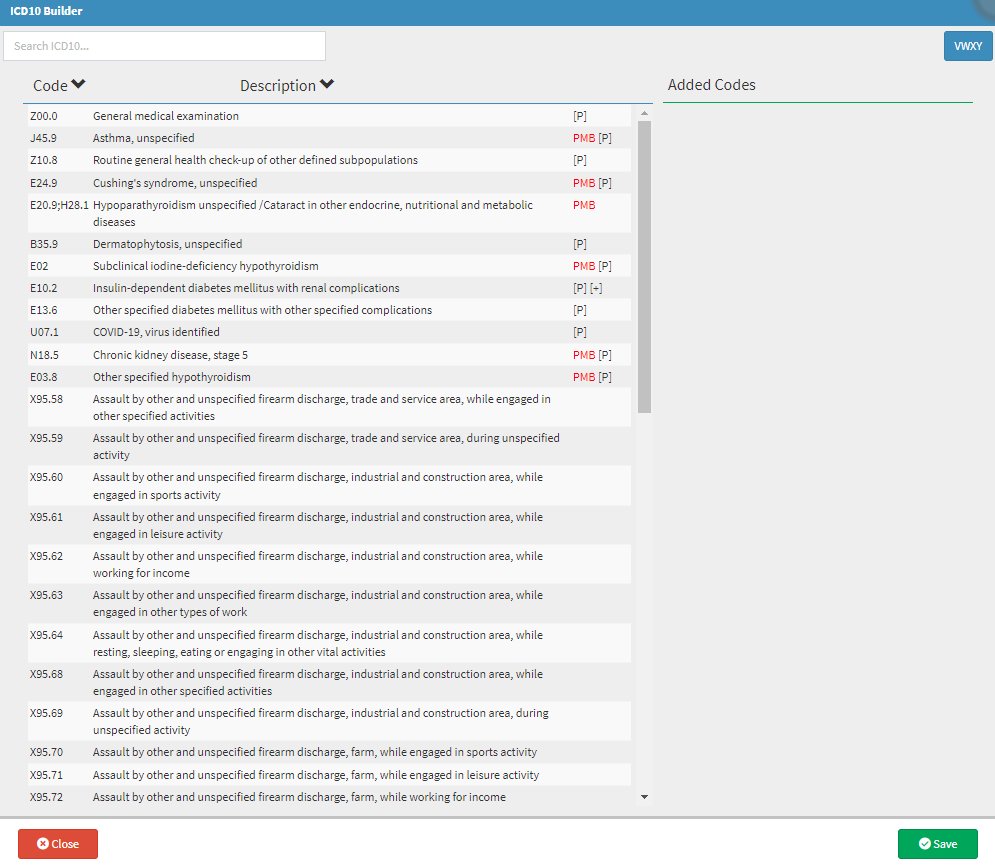
- For more information regarding the ICD-10 Builder screen, please refer to the user manual: Procedure/Material/Medicine/Macro/ICD-10 Search Code Lookup.
Billing Codes
Billing Codes are codes used to bill procedures and/or items used during the evaluation. The Practitioner can add all the relevant Billing Codes of the examination directly on the form. When the Practitioner is satisfied with the selections that have been made, the codes can be added to an Invoice.

Please Note: Billing Codes 0190 and 3009 are added by default in the Billing Codes section when the Eye Evaluation form is opened. The Practitioner can decide whether to keep or remove the codes from the section.

- Click on the + Add Procedure Line button to add more Billing Codes. The Practitioner is able to add as many Procedure lines as needed.
![]()
- A new billing line will open where the Practitioner is able to add the desired Billing Code.
![]()
- Click on the Type to Search... field to start typing the name or code (if known) of the item that the Practitioner would like to bill.
![]()
- A list will appear as the user types, from which the Practitioner is able to choose the desired Billing Code.
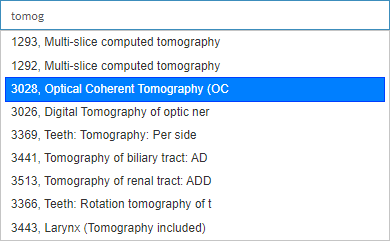
- Click on the desired item, on the list that has opened, to add the Billing Code to the billing line.
Please Note: Once the Billing Code has been added to the billing line, the description will automatically be filled in.

- Click on the corresponding Quantity field to change the number of items that will be billed for the specific Billing Code.

- Click on the Add to Invoice button to add all Billing Codes that have been added to the Billing Codes section to the Patients' invoice.
![]()
- A notification will appear in the bottom right-hand corner of the screen to advise that lines have been added to the invoice.

- For more information regarding how the Invoice works and how to post the Invoice, please refer to the user manual: The Invoice Screen.
Complete and Finalise All Stages
Once the Practitioner is satisfied with the information added to the Eye Evaluation form the form can be completed and all the stages of the form can be finalised.Complete
- Click on the Complete button to complete the Eye Evaluation.
![]()
- The button will change to Completed and will be marked as Completed at the top of the screen.
![]()
Finalise All Stages
- Click on the Finalise All Stages button once the Eye Evaluation has been concluded and the Practitioner has finished the evaluation and billed the Patient.
![]()
Please Note: Once the Practitioner has Completed or Finalised All Stages of the Eye Evaluation, no changes can be made to the content of the form.
Allows the Practitioner to send a copy of the Eye Evaluation via electronic mail
- Click on the Email button to send a copy of the Eye Evaluation via electronic mail to the desired recipients.
- The Email - Workflow Event screen will open.

Please Note: The Eye Evaluation will be automatically attached as a PDF (Portable Document Format) file in the Attachments section.

- Complete the fields with the relevant information:
- To: The email address of the recipient. The Debtor's email address will automatically be filled in the To field.
- Cc: Carbon Copy - Mailing addresses of other recipients who will also receive the email as a reference to take note of the email that has been sent to the main recipient.
- Bcc: Blind Carbon Copy - A copy of the original email will be sent to the added mailing addresses without the main recipient's knowledge, which is used for privacy purposes.
- Subject: A single line of text, that informs the recipient what the email is about.
- Click on the Close button to exit the Email - Workflow Event screen without sending the email.
![]()
- Click on the Send button to send the email to the desired recipient and exit the Email - Workflow Event screen.
Print and Downlaod
Allows the Practitioner to print out a hard copy of the evaluation that can be filed in the Patient's hard copy file or save a PDF (Portable Document Format) copy to the Practitioners' device.
- Click on the Print button to open a preview to allow the Practitioner to print a hard copy of the Eye Evaluation.
![]()
- The Print screen will open. The Eye Evaluation will display on the screen.

- Click on the Cancel button to exit the Print screen without printing.
![]()
- Click on the Print button to send the Eye Evaluation to the printer. the Print screen will close and return to the Eye Eval screen
Download
- Click on the Print drop-up menu to open additional print options.

- Click on the Download button to save the Eye Evaluation as a PDF (Portable Document Format) to the user's computer.
![]()
- The PDF (Portable Document Format) file of the Eye Evaluation will be downloaded to the user's device.

Save and Close
Allows the Practioner to save all the changes that have been made to the Eye evaluation and close the form.- Click on the Close button to exit the Eye Eval screen without saving.
- Click on the Save and Close button to save all changes that have been made and close the Eye Eval screen and return to the Diary screen.
![]()
- Click on the Save and Close drop-up menu for more options:
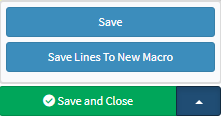
- Save: The user is able to save the changes made to the form without closing the form.
- Save Lines To New Macro: Allows the user to create a new macro.
- For an extensive explanation of the New Macro feature, please refer to the user manual: Macros (Billing Combinations).